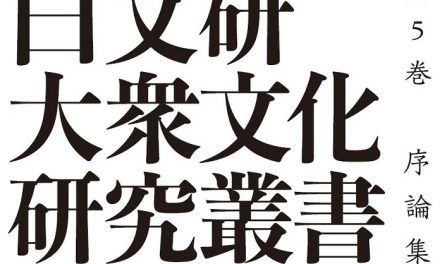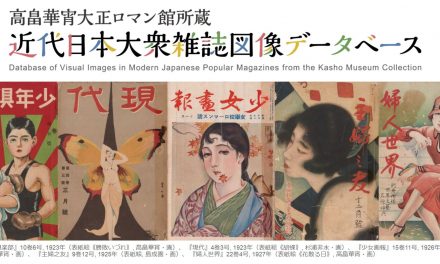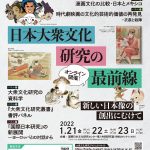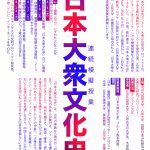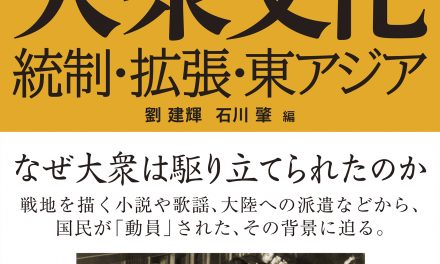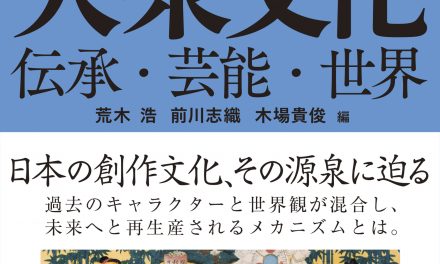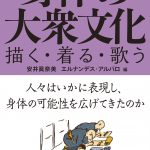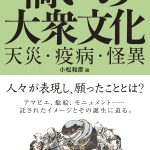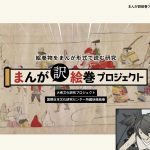
2018年9月の「日本大衆文化シリーズ講座in北京」教育プログラム動画を公開中!!
2018年9月に北京で行われた日本大衆文化シリーズ講座の映像を公開いたします(大塚英志教授の講義「戦時下東宝映画文化工作と戦後日本サブカルチャーの発生」は非公開の資料を使用しているため、動画配信をすることができません。ご了承下さい)。
講義1
細川周平「近代日本音楽史の輪郭」
要旨:
1853年のアメリカ軍艦(「黒船」)到来は、他の分野と同じく音楽の分野でも時代を画す出来事だった。強力な軍事力が特別な楽音の命令系統を持って機能していることを知った日本側は、積極的に学習を開始し、背後の音楽文化が科学・哲学・政治・経済などと連動した「世界音楽システム」と呼んでもよい括りであることを学んだ。それはおよそ次の特徴を持っていることを少しのうちに学んだ。1)数理的構造(平均律音階)、2)記号の支配(楽譜)、3)公共的教育体制(学校)、4)自律美学(美そのもの)、5)公開演奏会、6)国家・民族主義(国歌、国家の代表・象徴)。この授業ではこれらの受容のさまざまな局面を概観し、音楽文化の近代化について考える。
講義2
荒木浩「投企する古典性―ブッダ・『源氏物語』・聖徳太子から考える―」
要旨:
日本古典文学は、先行する国内外の作品や叙述の型などを受け止め咀嚼し、新しい世界観やキャノン、あるいはキャラクターを生み出して、文化の重層性を形成してきた。本講座では、この構造の大枠を、投影や投げ出しの意味を持つ「投企(project)」という語で逆転的に捉え、日本の古典文学が、いかにしてその作品性や世界観を投企して展開してきたか、という視点で日本古代・中世文学を論じたい。具体的には『源氏物語』の形成に投影されたブッダの伝記のイメージについて独自の分析を行い、また光源氏のモデルともなった聖徳太子というキャラクターが担った、インド・中国文化への投企性について考察するなど、議論を展開し、「投企する古典性」という概念を検討したい。
講義3
小松和彦「幕末の江戸の大衆文化を覗く」
要旨:
嘉永6年(1853)、幕末の幕開けを告げる、マシュー・ペリーが率いるアメリカ合衆国海軍の蒸気船2隻を含む艦船4隻(いわゆる「黒船」)が来航し、「泰平の眠りをさます上喜撰たつた四杯で 夜も眠れず」と狂歌で囃されたように、江戸の町は大騒動となった。翌年再来航したペリーと幕府の間に日米和親条約が締結され、日本の鎖国が終わった。そんななか、安政2年(1855)10月2日、江戸の町を大地震が襲い、大きな被害がもたらされた。この講義では、そのような時代に描かれた妖怪をテーマした浮世絵を手がかりに、たった一枚の絵であっても、その内容を読み解くことがいかに難しいかを学ぶとともに、その解読を通じて浮かび上がってくる江戸の庶民文化の一端を覗いてみることにしたい。
講義4
劉建輝「制度の歴史から感情の歴史へ―画像資料でたどる日本人の「満洲」幻想」
要旨:
日露戦争後、大連をはじめとする新たに獲得した権益の土地を目指して多くの日本人が中国の東北部に移住した。その数は終戦時の統計で言うとおよそ150万人にも達している。従来、この日本人移民の問題を取り扱う時、ほとんどの研究が主に政策や制度、または軍事や経済の側面からこれを考察してきた。しかし、はたして政府の政策や勧誘だけでこんな大規模の移住を実現することができたのだろうか。本講義では、日露戦争以来刊行されたさまざまな地図や旅行案内図、絵葉書などを素材に、これらの表象がいかにいわゆる「満洲」への幻想を作り上げ、そしてその幻想がいかに多くの国民をこの「新天地」に赴かせたかについて検証し、従来の政策や制度史だけに偏る方法論を正し、あわせて画像資料の歴史研究における有効性も実証したい。
講義5
安井眞奈美「出産の習俗と怪異伝承―うぶめの絵を手がかりに」
要旨:
18世紀、日本でさまざまな妖怪が描かれて人気を博した頃、妊娠中・出産時に亡くなった女性の妖怪であるうぶめ(産女・姑獲鳥)も描かれるようになった。妖怪画は、江戸時代に妖怪を娯楽の対象として楽しむようになった大衆文化の一端を表しており、その中でうぶめの絵は、当時の出産・産後の習俗を示す資料としても読むことができる。この講義では、妊娠から出産、産後にかけての習俗や伝承を紹介し、生児を産み育てていくことが難しかった時代に、人々がどのような知恵や工夫をもって生き抜こうとしてきたのかを読み解いていく。あわせて、近代から現代にかけて、出産のあり方が大きく変容する中で、出産の習俗や、人々のいのちに対する意識がどのように変わってきたのかについても考察したい。
Educational program videos “Japanese Popular Culture Lecture Series: In Beijing” (September 2018) now available online
Videos showing the series of Nichibunken lectures on Japanese Popular Culture held in September 2018 in Beijing, are now available. (Professor Ōtsuka Eiji’s lecture on “Senjika Tōhō eiga bunka kōsaku to sengo Nihon sabukaruchā no hassei” (Toho’s Wartime Film Culture Maneuvering and the Emergence of Postwar Japanese Subcultures) is not available due to the inclusion of information subject to a nondisclosure agreement.)
Lecture 1
Hosokawa Shūhei, “Kindai Nihon ongaku shi no rinkaku” (Outline of the History of Modern Japanese Music)
Abstract
The arrival of the American warships (the“Black Ships”) off Japan in 1853 was an epochal event for Japanese music, as it was for many other fields of culture. Learning about the significant part played by music in the command system of a powerful military, the Japanese side started the active study of modern music and found that the “background music culture” might be encapsulated as a “world music system” linked to science, philosophy, politics, the economy, and so on. Japan soon became aware of the following features of music: it had a mathematical structure (the equal temperament scale); it was governed by symbols (musical notation); [it could play an important role in] public education (schools); its beauty is autonomous (intrinsically beautiful); [potential for] public concerts; and [its role in projection of] statism/nationalism (through a national anthem and representation and symbolism of the state). Giving an overview of various aspects of the reception of modern music, this lecture examines the modernization of music culture in Japan.
Lecture 2
Araki Hiroshi, “Tōki suru kotensei: Budda, Genji Monogatari, Shōtoku Taishi kara kangaeru” (Projection in the Classics: Shakyamuni Buddha, The Tale of Genji, and Prince Shōtoku)
Abstract
The acceptance and digestion of domestic and overseas works and the descriptive styles therein of previous times in classical literature and the creation of new worldviews, canons, and characters formed the multilayered character of Japanese culture. This lecture understands the framework of that multilayered structure in reverse fashion using the keyword “project/projection” in the sense of displaying something outwardly. It discusses ancient and medieval Japanese literature from the viewpoint of how classical literature projected its content and worldviews in the course of its development. As a specific example, the lecture analyzes the biographical images of Shakyamuni Buddha projected in the formation of the Genji monogatari (The Tale of Genji), and also speculates on the projection of Indian and Chinese cultures through Prince Shōtoku, considered the model of Hikaru Genji, the protagonist of the Tale. The concept of “projection in the classics” (tōki suru kotensei) is proposed and explored in the course of the discussion.
Lecture 3
Komatsu Kazuhiko, “Bakumatsu no Edo no taishū bunka o nozoku” (Glimpses into Popular Culture in Edo at the End of the Tokugawa Shogunate)
Abstract
In 1853, the arrival in Japanese waters near the shogunal capital of Edo (now Tokyo) of the U.S Commodore Matthew Perry-led four “black ships,” including two steamships, marked the beginning of the end of the long rule of the Tokugawa shogunate. As expressed by a widely-circulated comic poem that goes “Awoken from a long and peaceful sleep by “jōkisen”* / Only four cups of it keep us awake at night” (*Play on words: “Jōkisen” means both steamships and the name of a costly brand of green tea), the black ships threw the city of Edo into an uproar. The conclusion of a treaty of peace and amity signed between Perry, who returned the following year, and the shogunate put an end to the national seclusion that had prevailed since the early seventeenth century. Then, on the tenth month of 1855 (Ansei 2), a massive earthquake hit Edo, causing enormous damage to the city. Examining ukiyo-e prints of yokai monsters produced at that tumultuous time, the lecture shows how difficult it is to decipher the content of even a single piece work of art, and by decoding yokai ukiyo-e, provides glimpses of the folk culture of Edo.
Lecture 4
Liu Jianhui (Ryū Kenki), “Seido no rekishi kara kanjō no rekishi e: Gazō shiryō de tadoru Nihonjin no “Manshū” gensō” (From a History of Institutions to a History of Emotions: The Japanese Fantasy of “Manchu” as Shown in Pictorial Documents)
Abstract
After the Russo-Japanese war, many Japanese moved to the northeastern part of China, heading for settlements in the area of Dalian and other newly acquired concessions. Their number reached some 1.5 million, according to statistics at the time of the end of World War II. In dealing with this Japanese migration issue, most previous studies have considered it mainly from the perspectives of policy or institutions, or in terms of the military, and/or economic ramifications. Was such a large-scale migration made possible by government’s policies and incentives alone? Using different kinds of maps, travel guides, picture postcards, and other reference materials published since the Russo-Japanese war, this lecture examines how these publications generated images (illusions) of “Manchuria” and how those images lured Japanese to what was portrayed as the “new world.” This research hopes to rectify methodologies placing excessive weight on government policies and institutions to demonstrate the effectiveness of pictorial documents in historical research.
Lecture 5
Yasui Manami, “Shussan no shūzoku to kaii denshō: Ubume no e o tegakari ni” (Childbirth Customs and Folktales about Unnatural Phenomena: Hints from Pictures of “Ubume”)
Abstract
Depictions of various yokai monsters in eighteenth-century Japan popularized yokai. The yokai of a woman who died of pregnancy or during childbirth, known as Ubume, was also produced at that time. Yokai pictures became part of popular culture as Edo-period people came to enjoy yokai for entertainment. Ubume paintings can be seen as sources showing childbirth and postpartum customs. This lecture introduces customs and folktales related to pregnancy, childbirth, and the outcome of birth, and shows how people managed to survive by their wits at a time when it was difficult to give birth and raise a child. Childbirth has greatly changed in modern times, and the lecture also considers how childbirth customs and people’s attitudes toward life have changed.

